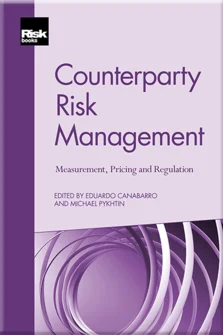Best Market Practice for Calculation and Reporting of Wrong-Way Risk
Andrew Aziz, Bob Boetcher, Jon Gregory, Alex Kreinin
The Basel III Enhancements to Counterparty Risk Capital Charges
The Regulation of Counterparty Risk in Over-the-Counter Derivatives Markets
The Non-Internal Model Method for Counterparty Credit Risk
On Credit Valuation Adjustments and Regulatory Capital
American Monte Carlo: A Practitioner Approach
Best Market Practice for Calculation and Reporting of Wrong-Way Risk
Central Counterparty Risk
CVA Risk Management Post-Crisis
Re-Thinking CVA: Valuations, Counterparty Credit Risk and Model Risk
Should Derivatives Dealers Make A Funding Value Adjustment?
Adjoint Algorithmic Differentiation: Real-Time Counterparty Credit Risk Management in Monte Carlo Simulations
Stress Test of Counterparty Risks and Dynamic Hedging of the CVA
Dynamic Stress Testing of Counterparty Default Risk
Collateral: Modelling, Pricing and Optimisation
 The global financial crisis that began in 2007 illustrates the importance of the correct quantification of counterparty risk arising from bilateral over-the-counter (OTC) derivative contracts. There has consequently been a significant amount of effort in quantifying counterparty risk via credit value adjustment (CVA) and debt value adjustment (DVA). Both regulatory capital requirements (Basel III) and accounting standards (IFRS 13) contain significant provisions for CVA capitalisation and reporting. In line with these changes, most banks with material OTC derivative portfolios have some sort of “CVA desk” with the responsibility of pricing and managing CVA.
The global financial crisis that began in 2007 illustrates the importance of the correct quantification of counterparty risk arising from bilateral over-the-counter (OTC) derivative contracts. There has consequently been a significant amount of effort in quantifying counterparty risk via credit value adjustment (CVA) and debt value adjustment (DVA). Both regulatory capital requirements (Basel III) and accounting standards (IFRS 13) contain significant provisions for CVA capitalisation and reporting. In line with these changes, most banks with material OTC derivative portfolios have some sort of “CVA desk” with the responsibility of pricing and managing CVA.
Wrong-way risk (WWR) is a natural feature, added to the already complex framework for CVA quantification. WWR is a well-known relationship where the exposure to a counterparty is adversely related to that counterparty’s default probability. In the global financial crisis, the potential dangers of WWR were illustrated, for example, when banks lost billions of dollars due to largely uncollateralised trades with monoline insurance companies (see, for example, Gregory 2008). WWR is also seen by CVA desks in hedging where co
Copyright Infopro Digital Limited. All rights reserved.
As outlined in our terms and conditions, https://www.infopro-digital.com/terms-and-conditions/subscriptions/ (point 2.4), printing is limited to a single copy.
If you would like to purchase additional rights please email info@risk.net
Copyright Infopro Digital Limited. All rights reserved.
You may share this content using our article tools. As outlined in our terms and conditions, https://www.infopro-digital.com/terms-and-conditions/subscriptions/ (clause 2.4), an Authorised User may only make one copy of the materials for their own personal use. You must also comply with the restrictions in clause 2.5.
If you would like to purchase additional rights please email info@risk.net











